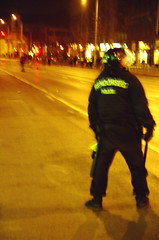A fair bit of attention has been paid in the blogs today to the assertion of McCain’s chief strategist Steve Schmidt that “The McCain campaign is roughly in the position where Vice President Gore was running against President Bush one week before the election of 2000.” It’s met a good dose of scepticism. The WaPo drily annotated the quote as follows:
McCain’s team dismisses the most dire polls — those showing the race nationally with a double-digit lead for Obama. Advisers believe the contest’s margin is in the five-to-seven-point range, about the same deficit, they say, that then-Vice President Al Gore faced at this time eight years ago against then-Gov. George W. Bush. (A Washington Post poll at the same point in the 2000 race showed a tie.)
NBC’s First Read similarly remarked:
[T]he NBC/WSJ poll right before the election found Bush ahead by three among likely voters (47%-44%). But our most recent poll shows Obama up [..] 11 points among likely voters (53%-42%).
In addition, Marc Ambinder points out that the margins are “way different” state-by-state: “Obama’s doing much better in 2008 than Al Gore was in 2000 in the battleground states.”
Now I had a graph up here a week or two ago charting how Obama’s current Gallup numbers compare with the lead or deficit that Kerry, Gore and Clinton faced in the previous three presidential elections. In the days since, Googlers have found this site through at least 27 permutations of searches involving some combination around Gore, Bush, polls, October, historical, 2000, elections, tracking and Gallup. So this is a good occasion to update that post and expand it, not just looking at the Gallup numbers but also those from the ABC, Zogby and TIPP daily tracking polls from 2000, 2004 and 2008.
First off, that chart from last time, based on the Gallup polling numbers from the last four elections. Here’s the update:

Continue Reading »






